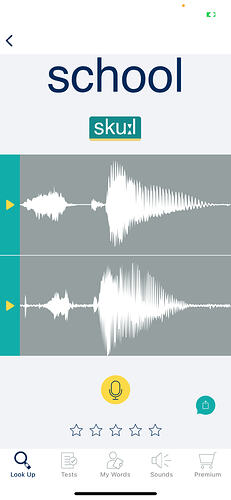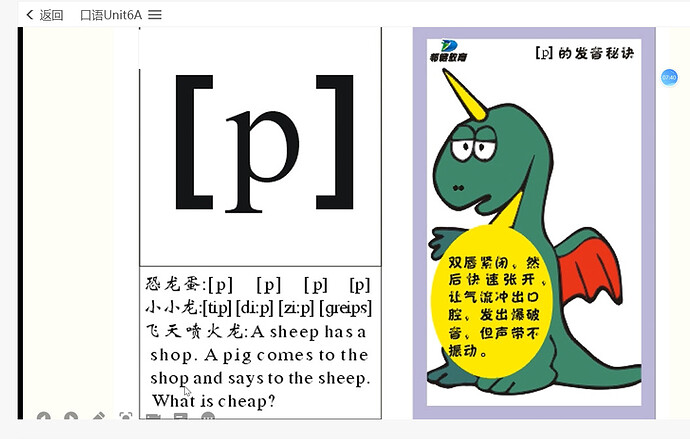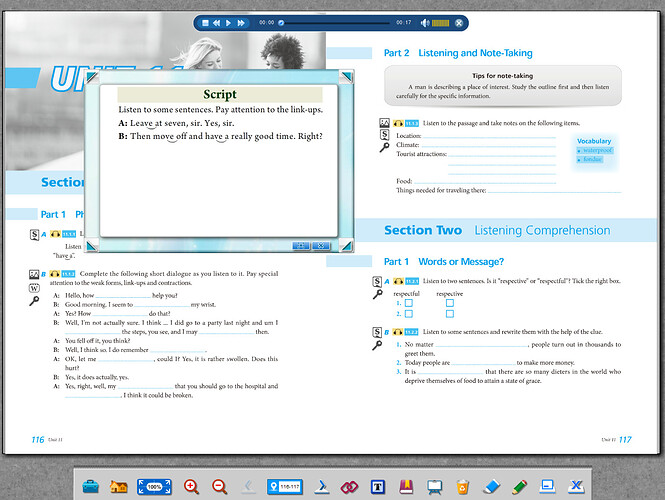目前我感受到的反而是杂牌军在偷着上课。而且就在文化宫…
我错过了本地50元一套的新东方全新学生桌椅,赶上了爱贝英语退费难…濒临倒闭偷着上师资力量降了又降
找到一个 app 牛津出的 叫 say it 不知道效果好不好,贼贵,88一月。![]() 不知道有效果么……
不知道有效果么……
s +plosive k, 图上那个三角形前面一点点大的就是这个k音了…
死记硬背没有扩展性,demo还提供另一个词,speak,我发了好多次都发不好,不能和示例一样。
还是难。
连了无数遍,成功一次。
s要果决,k要喉咙无声送气。
麻烦,还要买本啥书看看才好。这个app不是购买制,是订阅制相对于app来说又不便宜,都不敢无脑买
/k/在/s/后送气很弱,可视为不送气清辅音。
一般认为英语没有浊辅音,或者不明显。
有些人是根据喜欢的电视剧或者Podcast或者油管视频学会发音的。
按照普遍的学习方法,先学音标,而不是先学单词发音吧,把口型做到位,舌头到位。再自己根据音标试讲几遍,再听OED的发音进行纠正,再接着用Iphone上自带的翻译,录制发音,再看语音转换而来的单词准不准
[The Oxford Companion to the English Language (2 ed.)](https://www.oxfordreference.com/view/10.1093/acref/9780199661282.001.0001/acref-9780199661282) headword speech
PRINTED FROM OXFORD REFERENCE (www.oxfordreference.com). (c) Copyright Oxford University Press, 2021. All Rights Reserved. Under the terms of the licence agreement, an individual user may print out a PDF of a single entry from a reference work in OR for personal use (for details see Privacy Policy and Legal Notice).
Subscriber: Brent Library Service; date: 04 September 2022
Speech
- Source:
- The Oxford Companion to the English Language
- Author(s):
- Tom McArthurTom McArthur, Jacqueline Lam-McArthurJacqueline Lam-McArthur, Lise FontaineLise Fontaine
Speech.
1. The primary form of language; oral communication in general and on any particular occasion: Most people are more fluent in speech than in writing.
2. A usually formal occasion when a person addresses an audience, often with the help of notes or a prepared text.
3. A way of speaking, often involving a judgement of some kind: local speech, slovenly speech, standard speech.
4. The field of study associated with speaking and listening: the science of speech.
Anatomy and physiology
Speech is possible because of the development over millennia of an appropriate physical system: the diaphragm, lungs, throat, mouth, and nose, working together. All such organs preexisted the evolution of language and have such prior purposes as breathing, eating, and drinking. With the advent of speech, they continued to perform these functions while becoming available for additional uses, so that two systems (maintenance of the body and systematic communication) exist side by side. Vocal sound becomes possible when a stream of air is breathed out from the lungs and passes through the larynx, then into and through the pharynx, mouth, and nose. This sound may be voiced or voiceless: that is, the larynx may vibrate or not. Different sounds are made in the mouth by moving the lips, tongue, and lower jaw to change the size and shape of the channel through which the air passes. A consonant is made with a narrowing of the channel, and the point of maximum narrowing is the place (or point) of articulation for that consonant. The way in which this is done is the manner of articulation. A vowel typically has a wider channel than a consonant. Since it is difficult to be precise about the articulation of vowels, they are normally described by their auditory quality. In discussing articulation, phoneticians refer to an articulator, which may be active (as with the lips and tongue) or passive (as with the front teeth).
Place of articulation
For bilabial consonants, the narrowing is achieved by bringing the lips together. For labio-dental consonants, the active articulator is the lower lip. In other cases, the active articulator is part of the tongue, which is raised towards the passive articulator on the roof of the mouth: see table.
Sounds can be classified according to the active articulator, for example the tongue: apical sounds made with the tip (Latin apex); laminal sounds with the blade (Latin lamina); dorsal sounds with the back (Latin dorsum). Retroflex sounds are made with the tip of the tongue curled back behind the alveolar ridge towards the palate. However, the commonest classification is according to the passive articulator. This terminology assumes that the active articulator is the organ that lies opposite the passive articulator in the state of rest: for example, the passive articulator of a dental sound is the upper front teeth, and the active articulator is the tip of the tongue. If some other active articulator is used, it is specified explicitly: for example for /f, v/, the lower lip moves up to the upper teeth, and these sounds are labio-dental: see table. The ASPIRATE /h/ is usually described as glottal. In English, /h/ is like a voiceless vowel in that there is no fricative-like narrowing in the mouth, so that the greatest point of narrowing is in the glottis. Most sounds have one place of articulation, but /w/ has a double articulation, being made by simultaneously rounding the lips and raising the back of the tongue towards the velum. It is thus both bilabial and velar.
Manner of articulation
This refers mainly to the degree of narrowing at the place of articulation of a sound. If the airstream is blocked completely, the result is a stop, such as /b/, but if it is narrowed to the point where noise or turbulence is generated as air passes through the gap, the resulting sound is a fricative /v/. In the case of an approximant or continuant, the manner of articulation is more open, as with the /r/ of rink as compared to the /z/ of zinc (a voiced fricative). When a stop is released, the articulators move apart and necessarily pass through the degree of narrowing which produces fricative noise. A plosive is released quickly, whereas an affricate is released slowly:
plosives |
/p, b; t, d; k, g/ |
affricates |
/tʃ, dʒ/ |
fricatives |
/f, v; θ, ð; s, z; ʃ, ʒ; h/ |
There are several types of approximant. The velum is normally raised to prevent air from entering the nose: a NASAL is produced with the velum lowered. The airstream normally passes centrally through the mouth: in the case of a lateral, the air escapes at the sides. The tongue normally offers a convex surface to the roof of the mouth: for an r-sound, the tongue surface is often hollowed out and the tip raised. A GLIDE or semi-vowel is vowel-like and moves rapidly into the following vowel, and cannot be prolonged:
nasals |
/m, n, ŋ/ |
lateral |
/l/ |
r-sound |
/r/ |
glides |
/j, w/ |
Phoneticians conventionally describe consonants according to their articulation.
Articulator |
Description |
Examples |
|
|---|---|---|---|
Active |
Passive |
||
lower and upper lips |
– |
labial |
/p, b, m/ |
lower lip |
front teeth |
labio-dental |
/f, v/ |
tongue: |
|||
tip |
front teeth |
dental |
/θ, ð/ |
tip |
alveolar ridge |
alveolar |
/t, d, s, z, n, l, r/ |
tip/blade |
ridge/palate |
palato-alveolar |
/ʃ, ʒ, tʃ, dʒ/ |
front |
palate |
palatal |
/j/ |
back |
velum |
velar |
/k, g, ŋ/ |
早上我看了 Rachel’s English 关于 excuse 这个词的教学视频,大概也许我没看懂, sk 这个地方她跳过了……
我还是希望有个继续。
比如牛津简明语言学上,把hope的h音,写的很明白,h不发音只送气,和后面的o一起才有音。o又因 o_e 结构,o发本音。
难道如剑桥语音在用教程说的, k or g 在 单词中间或结尾时,你经常不能听清楚。
推荐给小孩看英语兔的这个视频
虽然讲的东西并不浅,但因为是视频,比用文字的容易听进去。
你推荐给我容易,我推荐给我小孩看就难了
谁懂
我觉得还好啊,一开始就讲清楚/k/其实有三种音,然后指明哪种情况下读哪个音,比起说sky是浊化好,一来本来就不是浊化,二来学生会疑惑为啥不直接写成/g/(因为本来就不是嘛)。
一开始就讲清楚,增加的只是学生的记忆负担(因为要记三种情况),要是能进一步讲清楚之所以会这样是为了发音方便,那么这个记忆负担都可能不存在。
但是一开始瞎讲什么浊化,搞得学生混淆一气,以后还有纠正的成本,而且实际上还是要记什么时候“浊化”,记忆负担并没有减少。
“兔老爹”讲得很好,但并不适合小孩子看,如果是少儿英语课程那么课程本身是不成功的。小孩儿学语言方法其实很简单,俩字,“模仿”,只要老师发音标准就可以了,至于那些规则反倒是加重了儿童的学习负担,容易削弱孩子的兴趣。
“浊化”的说法虽说不十分科学但也十分形象,大一点的人理解起来应该不会有太大的困难,所以授课对象是初中生,这么教无可厚非。
我觉得这些发音中的“音变”现象教学中不必刻意去强调,作为语法规则去讲更是画蛇添足了。
英语本就是大杂烩,连英国和美国自己都没有官方机构去规范,所谓的“伦敦腔”大概率就我们“北京话”翻版的讹传,连英国女王自己都否认过,说伦敦腔很土啊。
我上面提到的老师、不是学校里的老师,不具有长期连续教导的可能性。只是刚报的补习班的老师。之前一直在外国人教的那里学,没有这种问题,现在没有了。少年宫里有地下教室在教英语。我们就报了个班。
涂鸦画掉excuse的c写个g后,演示了几遍发音,为了把声音发的大一点,老师在他以为的g后面加了个ə,即 gə
小孩回到家我检查作业的时候发现被教成了 excuse /ik’s gəju:z/, 这才是我昨天有点生气加认真的原因。
而且他们上的是新概念,不是口语课课、音标课,再加上老师随口一提,对小学生来说,这么一笔带过只能是误人子弟。
我还在找这方面的课程。
我上午查了Google,下午去翻了翻我自己英语专业课的网课视频录播,发现老师也没讲到这一点……
口语课老师说某一节听力课上一定会讲到的,但是我没找到。哈哈哈笑哭了都
你儿子老师标成/g/的做法,有点像大聪明教北京话,告诉你说话含糊不清末尾再加个“儿”就是了!误人子弟啊!
gə
昨天花了两个小时把小孩口音拉回来。
和 h 一样,送气就好,声带不振动,不用发音,后面接着 ə 的时候才会有音。
但是默认教语音的时候,我之前听到的,大多是 h音 用 hə 表达,
给你推荐一个:童老师讲《牛津树》。英音普通话都很标准,专门给孩子讲的绘本,一套学完小学够用了。
我家孩子跟着外教学了很久了,只是之前学的都是自然拼读法,
一节课就口音被带歪了……
也不能迷信外教 ![]()
原因见#22楼。
不要生气,小孩犯错很正常,你帮他纠正过来就行了。学习本就是从犯错中寻找正确答案。
我见过很多小孩就是因为家长检查作业时但凡出现几个错误就大发雷霆,既没有学到正确知识,反而惧怕检查作业,进而害怕做作业。
最要命的是养成反复检查一个题的坏习惯。做作业一共需要一小时,反复检查一个题而后动笔下一题,做作业时间就被拉长至两个小时甚至三个小时。
这个时候家长反应过来了,多半会想"这小子是不是在蒙我?说是在做作业,其实是在玩咧!什么作业需要三个小时?"
问题又来了,多数家长为了省事也并不会过问原因,而是将自己臆测的内容当作事实,又来责怪小孩,指不定小孩还挨顿打。
小孩纳闷了,我认真做也要被打,我不认真做也要被骂,学习对他来说只有负面印象。
所以通常教师会建议家长不要辅导作业,专业的事情交给专业人士来做,除非你坚信你比老师专业。
如果家长一定要辅导学生作业,最好使用摄像机记录下辅导时家长的言行,事后观察自己是否管理好了情绪,不要视犯错为洪水猛兽。
不要相信专业的事交给专业人士来做这句话。因为世界上的每个行业只有少部分人士是精英,其他的可以说是庸庸大众。这句话最体现的是惰性思维,惯性的信服权威。
因为许多事,就算是敬业的专业人士也做不好,比如投资股票买基金,基金经理虽然是专业人士,但是大部分的业绩也是不如人意。
是的,教小孩要耐心。
本论坛有个 经济学 glossary mdx 蛮好的。
对的。带小孩不生气的。就是气被别人带歪了。所以我自己要学会了再去教。






